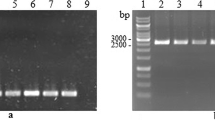Abstract
Genetic analysis of all Mucor-like fungi is severely impaired by the low efficiency of transformation systems and the genetic instability of the introduced plasmid constructs. The transformation efficiency of one of the model systems among mucoralean fungi, Absidia glauca, was improved considerably by microprojectile bombardment. For this purpose, a plasmid was constructed conferring (i) neomycin resistance as a selective marker and (ii) fluorescence due to expression of the gfp gene from the jellyfish Aequorea victoria. Compared with previous techniques, this method offers increased efficiency, with considerably easier handling than procedures based on protoplasts and, therefore, improved reliability. The uninucleate sporangiospores of A. glauca can be transformed early during the germination process. At this stage the number of nuclei ranges between 1 and 2. Thus, the abundance of transgenic nuclei in the coenocytic mycelia is high, and fewer problems are encountered with detecting low expression levels of the genes used for selection and monitoring of transformants.
Similar content being viewed by others
Author information
Authors and Affiliations
Additional information
Received: October 8, 2001 / Accepted: March 12, 2002
About this article
Cite this article
Bartsch, S., Schimek, C. & Wöstemeyer, J. Microprojectile bombardment as a reliable method for transformation of the mucoralean fungus Absidia glauca . Mycoscience 43, 0213–0217 (2002). https://doi.org/10.1007/s102670200031
Issue Date:
DOI: https://doi.org/10.1007/s102670200031




